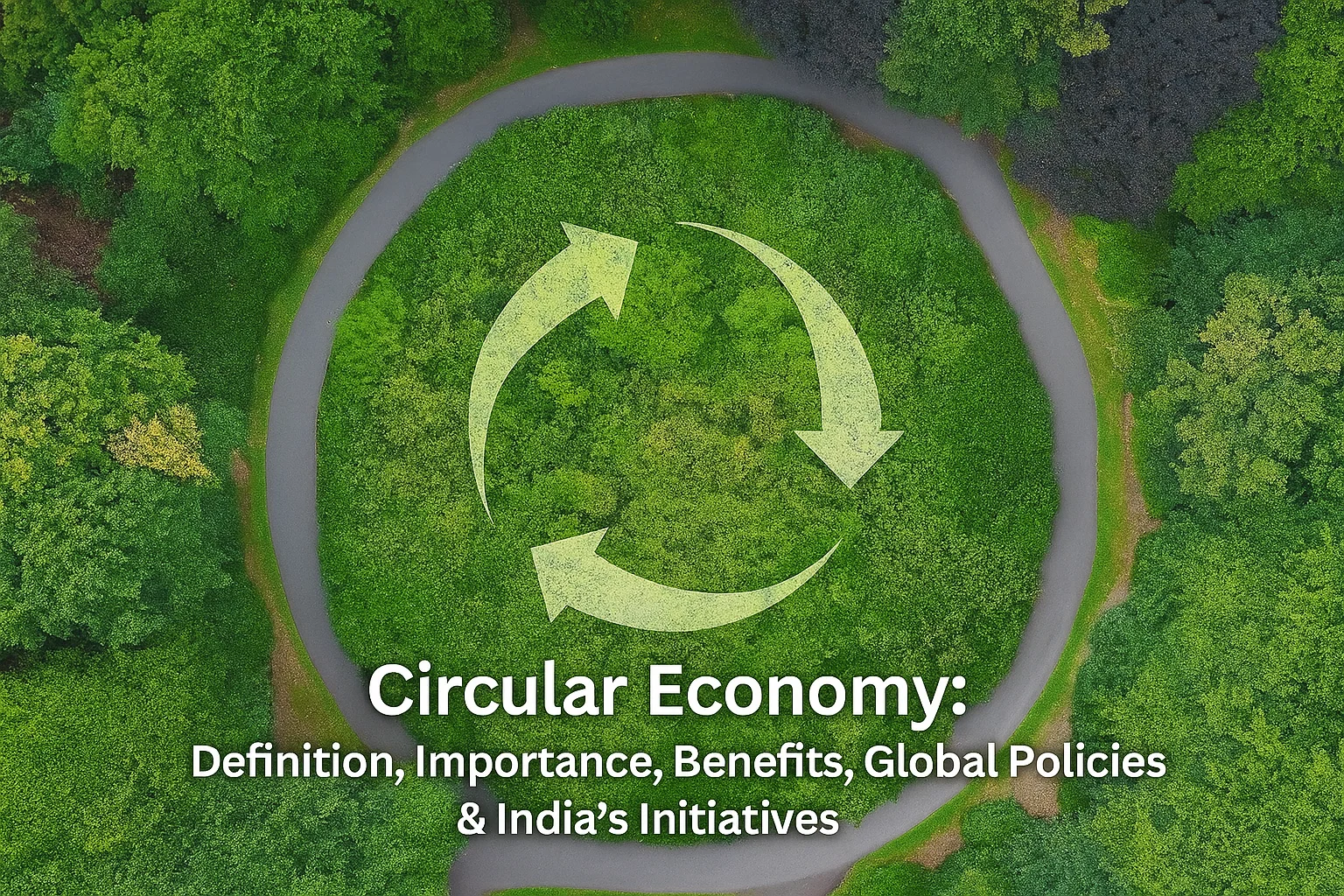Circular Economy: Definition, Importance, Benefits, Global Policies & India’s Initiatives
Understand the Circular Economy model, its role in sustainable development, climate action, resource efficiency, global practices, and India’s policies such as EPR, recycling frameworks, and NITI Aayog’s resource efficiency strategy.
Comprehensive Overview of the Circular Economy and India’s Circular Economy Policies
For nearly twenty years, the circular economy has been advanced as a model to decouple growth from resource depletion by minimising waste and extending product lifecycles.
What is a Circular Economy?
A Circular Economy (CE) is an economic system that decouples growth from resource extraction by designing products and processes that reduce waste, promote reuse, repair, remanufacturing, and recycling.
- As per UNEP, CE aims to keep materials in use as long as possible and recover maximum value from them.
- Unlike the linear “take–make–dispose” model, CE creates closed-loop systems, enhancing resource efficiency and lowering environmental impact.
Why is it Essential for Sustainable Development?
- Reduces Resource Depletion and Environmental Stress: CE slows the extraction of finite resources—critical when global demand for materials is projected to double by 2060 (OECD). It lowers pollution, emissions, and landfill pressure.
- Enables Climate Action: The UN International Resource Panel estimates that resource extraction contributes to over 50% of global GHG emissions. CE processes—remanufacturing metals, recycling solar modules, repairing electronics—reduce embedded carbon significantly.
- Offers Systemic Resilience in a Fragmenting Trade Order: As the article explains, global economic retrenchment, tariff wars, and resource nationalism disrupt supply chains. CE reduces dependency on volatile raw material markets by strengthening domestic secondary-resource loops.
- Drives Innovation and Green Jobs: CE facilitates new business models: repair-as-a-service, material recovery facilities, refurbished electronics, and industrial symbiosis. According to the World Economic Forum, CE could generate millions of green jobs globally.
How Can It Bolster the Indian Economy?
- Reducing Import Dependence on Critical Minerals: India imports large quantities of lithium, cobalt, nickel, aluminium, and copper. CE-based recovery of metals from electronics, EV batteries, and solar modules can cut import bills and strengthen strategic autonomy.
- Enhancing Manufacturing Competitiveness: The Economic Survey 2022–23 highlights India’s rising material consumption and the need for efficient resource use. CE boosts productivity by lowering input costs and improving value retention—critical for sectors like automotive, electronics, and textiles.
- Creating a Domestic Recycling Industry: India’s recycling market—already one of the world’s largest for metals and plastics—can grow into a USD 50–60 billion sector with formalisation, technology adoption, and extended producer responsibility (EPR).
- Supporting India’s Climate and Net-Zero Goals: Recycling aluminium uses only 5–10% of the energy needed for primary production. Solar PV recycling, modular design, and e-waste recovery contribute to India’s 2070 net-zero pathway.
- Strengthening Rural and MSME Sectors: Repair services, material recovery units, and textile circularity enhance local livelihoods and integrate MSMEs into green supply chains.
Are There Any International Conventions to Promote Circular Economy?
- Basel Convention (1989): Regulates transboundary movement of waste; recent amendments promote environmentally sound recycling of plastics and e-waste.
- EU Circular Economy Action Plan (2020): A global benchmark that mandates eco-design, recycling targets, and sustainable product policies.
- G20 Resource Efficiency Dialogue: Launched under India’s G20 presidency; promotes sharing of CE best practices among major economies.
- UN’s Agenda 2030 (SDGs): Targets under SDGs 6, 7, 9, 11, 12, and 13 explicitly recognise the need for circular, resource-efficient systems.
Have Any Countries Adopted a Circular Economy?
- European Union: The EU’s CE framework has led to higher metal recovery, product eco-labelling, and recycling rates above 45% in many countries.
- China: Adopted a Circular Economy Promotion Law (2009); leads globally in metals recycling, industrial symbiosis parks, and solar PV recycling.
- Japan: Follows a “Sound Material-Cycle Society” model with strong recycling markets and extended producer responsibility norms.
What Policies Have Been Taken for the Adoption of a Circular Economy in India?
-
National Frameworks
-
-
- NITI Aayog Strategy for Resource Efficiency (2019): sector roadmaps for metals, plastics, e-waste, and construction.
- Waste-to-Wealth Mission (Office of PSA): supports technologies for high-value recovery.
-
-
Legislative and Regulatory Measures
-
-
- Extended Producer Responsibility (EPR) rules for plastics (2016, updated 2022), batteries (2022), tyres, and e-waste.
- Battery Waste Management Rules (2022) integrate circularity into the EV ecosystem.
- Solid Waste Management Rules (2016) promote segregation, composting, and recycling.
-
-
Sector-Specific Initiatives
-
-
- Scrap Recycling Policy for Steel (2019) supports formal recycling and reduces energy intensity.
- PV Recycling Guidelines (MNRE draft) enable circularity in India’s fast-growing solar sector.
- Construction and Demolition Waste Rules support recycled aggregates and circular construction.
-
-
Institutional Support & Missions
-
- National Resource Efficiency Authority (NREA)—proposed to coordinate CE governance.
- Smart Cities Mission promotes waste-to-energy, material recovery facilities, and circular urban planning.
Subscribe to our Youtube Channel for more Valuable Content – TheStudyias
Download the App to Subscribe to our Courses – Thestudyias
The Source’s Authority and Ownership of the Article is Claimed By THE STUDY IAS BY MANIKANT SINGH



